INSTITUT SUPERIEUR D'ANTHROPOLOGIE
INSTITUTE OF ANTHROPOLOGY
ONLINE COURSES / COURS A DISTANCE
SUMMER TERM : JULY 2014
REGISTER NOW
ROYAUME UNI – 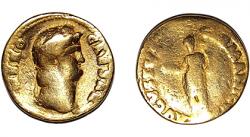 Vindolanda - In a breakthrough which defied two generations of diggers along Hadrian’s Wall, a volunteer French archaeologist has found the first gold coin at Vindolanda, the Roman site which has been intriguing excavators for almost 50 years. Described as being “well-worn”, the confirmed aureus bears the image of the Emperor Nero, dating it to around AD 64 or 65. The precious currency was worth half a years’ salary for serving soldiers, but was lost on the northern outpost of the empire following 300 years in circulation.Thousands of coins have been found at the former auxiliary fort, which is perhaps best known for revealing a treasured set of writing tablets.Beads, brooches, rings, leather shoes, arrowheads, pottery and a gaming counter have already been unearthed during the opening half of the digging season at Vindolanda. “You actually have more chance of winning the lottery than finding a gold coin on a Roman military site,” says Dr Andrew Birley, the Director of Excavations.
Vindolanda - In a breakthrough which defied two generations of diggers along Hadrian’s Wall, a volunteer French archaeologist has found the first gold coin at Vindolanda, the Roman site which has been intriguing excavators for almost 50 years. Described as being “well-worn”, the confirmed aureus bears the image of the Emperor Nero, dating it to around AD 64 or 65. The precious currency was worth half a years’ salary for serving soldiers, but was lost on the northern outpost of the empire following 300 years in circulation.Thousands of coins have been found at the former auxiliary fort, which is perhaps best known for revealing a treasured set of writing tablets.Beads, brooches, rings, leather shoes, arrowheads, pottery and a gaming counter have already been unearthed during the opening half of the digging season at Vindolanda. “You actually have more chance of winning the lottery than finding a gold coin on a Roman military site,” says Dr Andrew Birley, the Director of Excavations.
http://www.culture24.org.uk/history-and-heritage/archaeology/art487168-Archaeologists-hail-magical-moment-miraculous-Roman-gold-coin-find-Vindolanda
TURQUIE –  Antalya - Konya’s Selçuk University on June 17 launched Turkey’s first underwater archaeology research vessel in Antalya. With teams from Warsaw and Naples, the university will set off in July 1 to discover the underwater archaeological richness of the Mediterranean, spanning until Aug. 31. A ceremony was held at the Antalya Setur Marina to launch the vessel Selçuk-1. Selçuk University Rector Hakkı Gökbel said the vessel would also serve for marine biology research. The vessel, which will also work as the education vessel for the UNESCO Underwater Archaeology UNITWIN Network, belongs to the Selçuk University Underwater Research and Application Center. The 18-year-old, 26-meter-long vessel has a capacity for 20 people and was donated to the university by the Ministry of Food, Agriculture and Livestock. With its seven underwater cameras, sonar scanner systems, diving equipment and a lifter, the vessel is the only one in Turkey in the field. Within the scope of the ship’s summer program, an underwater excavation will be carried out in Antalya’s Adrasan cove.
Antalya - Konya’s Selçuk University on June 17 launched Turkey’s first underwater archaeology research vessel in Antalya. With teams from Warsaw and Naples, the university will set off in July 1 to discover the underwater archaeological richness of the Mediterranean, spanning until Aug. 31. A ceremony was held at the Antalya Setur Marina to launch the vessel Selçuk-1. Selçuk University Rector Hakkı Gökbel said the vessel would also serve for marine biology research. The vessel, which will also work as the education vessel for the UNESCO Underwater Archaeology UNITWIN Network, belongs to the Selçuk University Underwater Research and Application Center. The 18-year-old, 26-meter-long vessel has a capacity for 20 people and was donated to the university by the Ministry of Food, Agriculture and Livestock. With its seven underwater cameras, sonar scanner systems, diving equipment and a lifter, the vessel is the only one in Turkey in the field. Within the scope of the ship’s summer program, an underwater excavation will be carried out in Antalya’s Adrasan cove.
http://www.hurriyetdailynews.com/first-underwater-archaeology-vessel-launched-.aspx?pageID=238&nid=67965&NewsCatID=375
CHINE – Datong - An ancient tomb dating back 1,500 years has been unearthed in China's Shanxi province, offering researchers valuable material relating to the Northern Wei Dynasty. The tomb was excavated in the downtown city of Datong, the dynasty's ancient capital, also the centre for politics, economy, military and culture during that period, state-run Xinhua news agency reported today. Items found include painted potteries. Among them are yurt models with carts and servants crafted on the side, which are typical of the dynasty. The colours of the objects have been preserved due to the oxygen-free and humid underground environment. The well preserved state of the tomb provides valuable information about the lifestyle during the Northern Wei Dynasty (386-557), said researchers. Excavation is ongoing, according to Datong Institute of Archaeology. Thus far, no records about the owner of the tomb have been discovered.
http://www.outlookindia.com/news/article/Ancient-Tomb-Discovered-in-China/845434
ROYAUME UNI –  Warmington- The Neolithic burial near Warmington is believed to have been of some importance as at some point after the Romans arrived in Britain from AD43, they built a 12-sided building – probably a shrine – on top of the site. At one point this collapsed and had to be rebuilt because of the pit beneath. It was in this temple or shrine that one of the finest archaeological discoveries, an earthenware pot filled with silver Roman coins, was uncovered in 2008. It is now housed in Warwick Museum. Mr Freke believes the coins may have been left as a votive offering to whichever God the temple was dedicated to. He said: “The Neolithic burial mound was already 2,000 years old by the time the Romans arrived. To have something significant enough to persist like that is quite something.” Next to the shrine/temple structure the archaeologists have uncovered a second trench which they believe may show signs of a bank and rampart structure that may have formed a dividing line between two tribal territories in the Roman and Iron Age period. A few hundred yards further west is a third trench which has revealed the remains of four Roman buildings – one of which contained a hearth and a beaten earth floor.Finds suggest this may have been a workshop and smithy producing iron goods which were probably traded along an ancient trackway.
Warmington- The Neolithic burial near Warmington is believed to have been of some importance as at some point after the Romans arrived in Britain from AD43, they built a 12-sided building – probably a shrine – on top of the site. At one point this collapsed and had to be rebuilt because of the pit beneath. It was in this temple or shrine that one of the finest archaeological discoveries, an earthenware pot filled with silver Roman coins, was uncovered in 2008. It is now housed in Warwick Museum. Mr Freke believes the coins may have been left as a votive offering to whichever God the temple was dedicated to. He said: “The Neolithic burial mound was already 2,000 years old by the time the Romans arrived. To have something significant enough to persist like that is quite something.” Next to the shrine/temple structure the archaeologists have uncovered a second trench which they believe may show signs of a bank and rampart structure that may have formed a dividing line between two tribal territories in the Roman and Iron Age period. A few hundred yards further west is a third trench which has revealed the remains of four Roman buildings – one of which contained a hearth and a beaten earth floor.Finds suggest this may have been a workshop and smithy producing iron goods which were probably traded along an ancient trackway.
http://www.banburyguardian.co.uk/news/local-news/roman-finds-also-uncovered-at-site-1-6129613
ROYAUME UNI - Bridgend Farm - Archaeologists have unearthed the remains of a 16th century chapel built by the envoy to Mary Queen of Scots. Until recently, the exact location of the chapel, built by Sir Simon Preston in 1518,:was unknown A ten-strong team, including three archeologists from Rubicon Heritage Services, got to work on the site, known as the Bridgend Farm steading, off Old Dalkeith Road, last week. They managed to unearth a fragment of medieval floor tile which confirmed the building had a “high status in the area”.They also uncovered pottery from the 13th century – pre-dating the chapel – including a circular stone-lined medieval well.The chapel is believed to have survived The Reformation in Scotland in 1560, when many others were destroyed, while surveyors in 1853 noted that the building was being used then as a labourer’s house. The group believes the evidence now confirms the chapel is the one referred to in “local legend” – which was built by Sir Simon, of Craigmillar Castle, where Sistine Monks prayed for the souls of James III and James IV. Sir Simon lived from 1510 to 1570 and was Lord Provost of Edinburgh from 1565 to 1569 as well as being a member of the Privy Council of Scotland during Mary, Queen of Scots’ reign. He was sent to Scotland by Queen Mary in 1561 as her envoy to announce the death of her husband Francis II of France, as well as her decision to return to Scotland. However, his loyalty to Mary wavered before her final battle in Scotland at Langside, in 1568, after he signed a bond to defend James VI of Scotland and Regent Moray against her.
http://www.edinburghnews.scotsman.com/news/archaeologists-uncover-chapel-at-bridgend-farm-1-3450283
FRANCE – 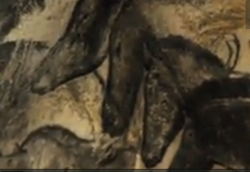 Grotte Chauvet - Située dans les gorges de l'Ardèche, la grotte Chauvet est avant tout l'une des premières galeries d'art de la planète : la plus ancienne trace d’un geste artistique. Candidate au patrimoine mondial de l’UNESCO, la grotte Chauvet sera restituée dans une réplique en 2015, à 5 km de l'originale.
Grotte Chauvet - Située dans les gorges de l'Ardèche, la grotte Chauvet est avant tout l'une des premières galeries d'art de la planète : la plus ancienne trace d’un geste artistique. Candidate au patrimoine mondial de l’UNESCO, la grotte Chauvet sera restituée dans une réplique en 2015, à 5 km de l'originale.
VIDEOGRAPHIE = http://www.dailymotion.com/video/x1zr3vp_la-grotte-chauvet_news
PEROU – 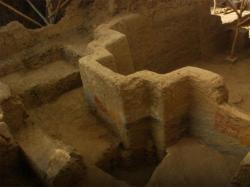 Ventarron -Findings at the archaeological complex of Ventarron, including a small Mochica temple located 4 kilometers away from the district of Pomalca in Lambayeque, were described as a “laboratory of original architecture” by Peruvian archaeologist and investigator Walter Alva. The pre-Hispanic site houses all the architectural forms such as circular walls, curved walls, curved rectangular structures, altars for fire worship, among others. Evidence for fire worship— the oldest tradition in America— is found at Ventarron temple, just as it was found in Caral, Kotosh, and Pirulo in the southern highlands. This means worship was already practiced by our ancestors before gods’ time, when some animals were depicted on the walls as part of nature. “There was a time when human beings began to emerge and make very complex architecture, but they were not influenced by gods yet. After that, gods became popular in the Chavin era,” he said. Ventarron is the site of a 4,000-year old temple with painted murals, which was excavated in Peru in the Lambayeque region on the northern coast, 760 km (470 mi) north of Peru’s capital of Lima. The site is about 12 miles from Sipan, a religious and political center of the later Moche culture, which flourished from AD 1 to AD 700 (about 2000 to 1300 years ago).
Ventarron -Findings at the archaeological complex of Ventarron, including a small Mochica temple located 4 kilometers away from the district of Pomalca in Lambayeque, were described as a “laboratory of original architecture” by Peruvian archaeologist and investigator Walter Alva. The pre-Hispanic site houses all the architectural forms such as circular walls, curved walls, curved rectangular structures, altars for fire worship, among others. Evidence for fire worship— the oldest tradition in America— is found at Ventarron temple, just as it was found in Caral, Kotosh, and Pirulo in the southern highlands. This means worship was already practiced by our ancestors before gods’ time, when some animals were depicted on the walls as part of nature. “There was a time when human beings began to emerge and make very complex architecture, but they were not influenced by gods yet. After that, gods became popular in the Chavin era,” he said. Ventarron is the site of a 4,000-year old temple with painted murals, which was excavated in Peru in the Lambayeque region on the northern coast, 760 km (470 mi) north of Peru’s capital of Lima. The site is about 12 miles from Sipan, a religious and political center of the later Moche culture, which flourished from AD 1 to AD 700 (about 2000 to 1300 years ago).
http://www.peruthisweek.com/news-temple-discovered-in-northern-peru-holds-evidence-of-fire-worship-103276
ITALIE – 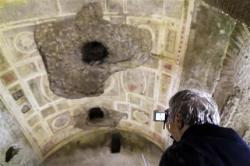 Rome - Experts say they've discovered how to rescue Nero's underground Golden Palace from further decay and eventually reopen the ancient emperor's entertainment complex to the public: uproot trees in the park that sits atop it. Archaeologists and restoration experts said Wednesday that research, including digital simulationsm, aimed at solving the Domus Aurea's chronic humidity problem, show that removing the trees will help prevent further damage. The nearly 2,000-year-old structure, under the Oppian Hill, was closed to visitors in 2010 after decades of stability problems. Tree roots and rainwater sink into the walls, damaging frescoes and causing parts of the ceiling to fall off. Also being developed is a system to expel humid air.
Rome - Experts say they've discovered how to rescue Nero's underground Golden Palace from further decay and eventually reopen the ancient emperor's entertainment complex to the public: uproot trees in the park that sits atop it. Archaeologists and restoration experts said Wednesday that research, including digital simulationsm, aimed at solving the Domus Aurea's chronic humidity problem, show that removing the trees will help prevent further damage. The nearly 2,000-year-old structure, under the Oppian Hill, was closed to visitors in 2010 after decades of stability problems. Tree roots and rainwater sink into the walls, damaging frescoes and causing parts of the ceiling to fall off. Also being developed is a system to expel humid air.
http://hosted.ap.org/dynamic/stories/E/EU_ITALY_NEROS_GOLDEN_PALACE?SITE=AP&SECTION=HOME&TEMPLATE=DEFAULT&CTIME=2014-06-18-11-32-02
AUTRICHE – 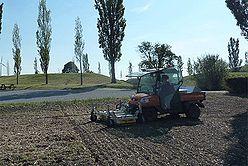 Carnuntum - Archaeologists have discovered one of the earliest Roman military camps in the Carnuntum on the Danube near Vienna. The discovery of the extensive military camp, that is believed to be the size of six football pitches, was done using a high tech radar machine that can detect objects deep into the ground. The camp was unearthed at the Archaeological Park Carnuntum, located in Lower Austria between Vienna and the Slovakian capital Bratislava. It was discovered near to the remains of an ancient village and researchers believe it is probably the earliest military camp at Carnuntum. The discovery follows that made a few years ago in the same area of a colossal Roman gladiator school that once stood on the banks of the River Danube. The remains were also discovered using innovative non-invasive archaeological techniques such as aerial mapping and ground penetrating lasers. The ground radar enables researchers to three-dimensionally map the remains of the Roman city, by monitoring the electromagnetic waves on a computer screen. By the end of 2014 they hope to cover a further four square kilometres using this method.
Carnuntum - Archaeologists have discovered one of the earliest Roman military camps in the Carnuntum on the Danube near Vienna. The discovery of the extensive military camp, that is believed to be the size of six football pitches, was done using a high tech radar machine that can detect objects deep into the ground. The camp was unearthed at the Archaeological Park Carnuntum, located in Lower Austria between Vienna and the Slovakian capital Bratislava. It was discovered near to the remains of an ancient village and researchers believe it is probably the earliest military camp at Carnuntum. The discovery follows that made a few years ago in the same area of a colossal Roman gladiator school that once stood on the banks of the River Danube. The remains were also discovered using innovative non-invasive archaeological techniques such as aerial mapping and ground penetrating lasers. The ground radar enables researchers to three-dimensionally map the remains of the Roman city, by monitoring the electromagnetic waves on a computer screen. By the end of 2014 they hope to cover a further four square kilometres using this method.
http://austriantimes.at/news/General_News/2014-06-18/51287/Earliest_military_camp_discovered_at_Carnuntum?